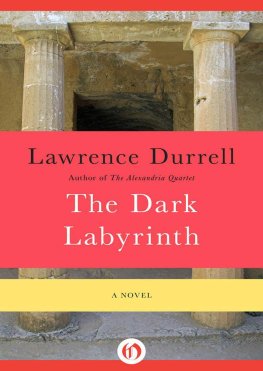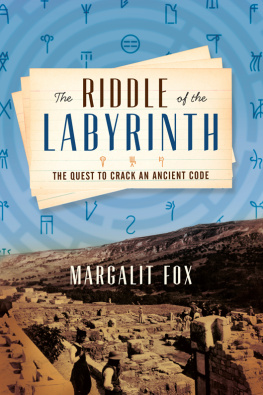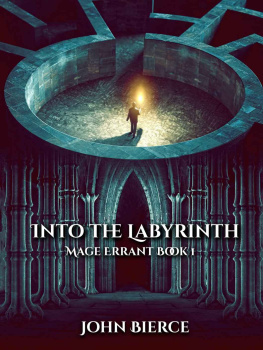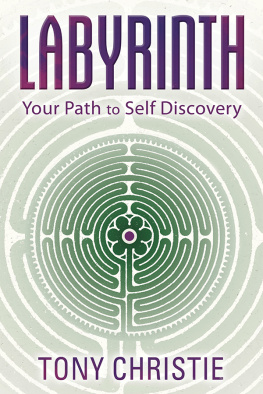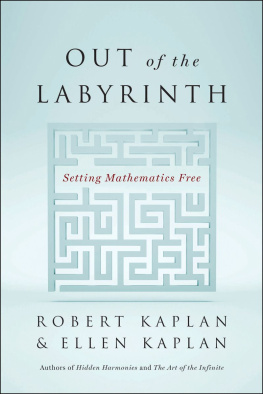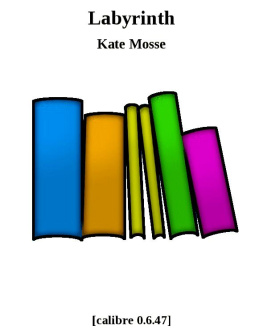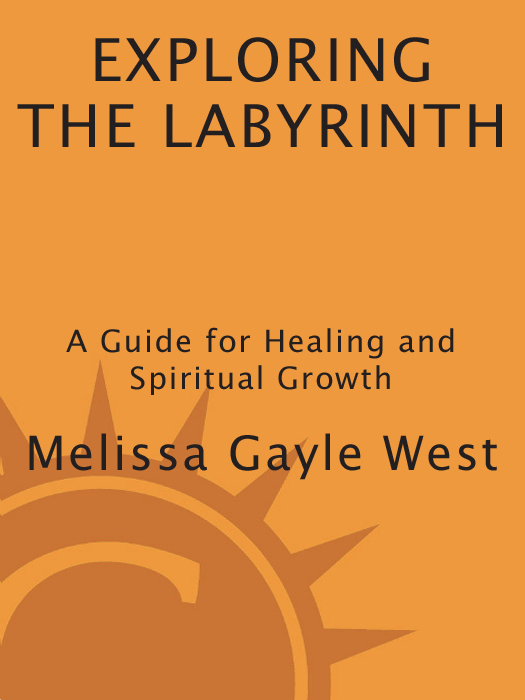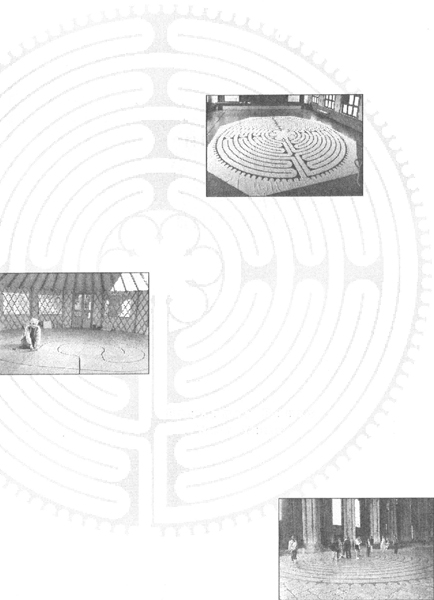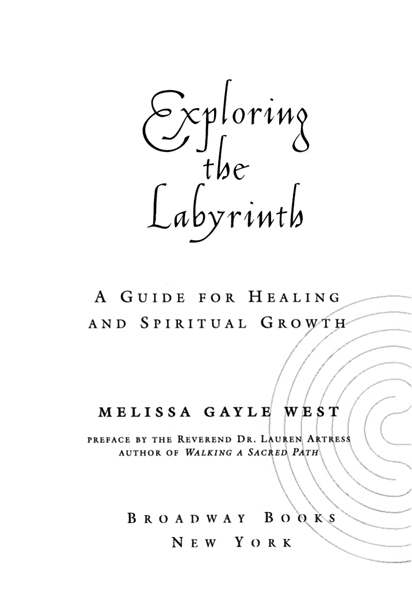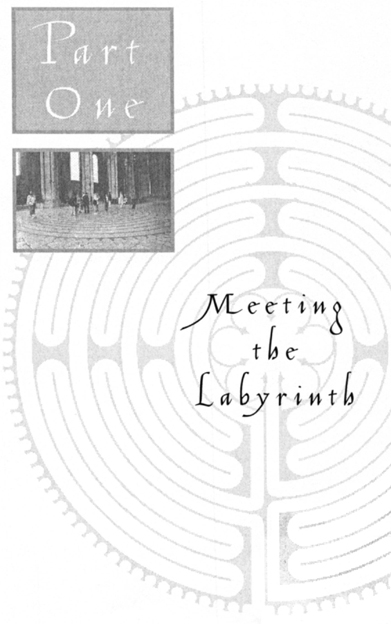
EXPLORING THE LABYRINTH . Copyright 2000 by Melissa Gayle West. All rights reserved. No part of this book may be reproduced or transmitted in any form or by any means, electronic or mechanical, including photocopying, recording, or by any information storage and retrieval system, without written permission from the publisher. For information, address Broadway Books, a division of Random House, Inc., 1540 Broadway, New York, NY 10036.
BROADWAY BOOKS and its logo, a letter B bisected on the diagonal, are trademarks of Broadway Books, a division of Random House, Inc.
Library of Congress Cataloging-in-Publication Data
West, Melissa Gayle.
Exploring the labyrinth: a guide for healing and spiritual growth
Melissa Gayle West. 1st ed.
p. cm.
Includes bibliographical references.
eISBN: 978-0-307-78960-0
1. LabyrinthsReligious aspectsPsychology. 2. Spiritual life.
I. Title.
BL325.L3W47 2000
291.37dc21
99-28662
I LLUSTRATIONS BY R ICHARD W AXBERG
The illustration on is based on a
design by Robert Ferr.
v3.1
To Gretchen,
book midwife extraordinaire,
for her dedication to the labyrinth
To Peter,
for introducing me to the labyrinth
and to She Who Knows,
always and forever at the Center
Acknowledgments
It takes one village to raise a child, they say, and I think no less is true for writing a book. I am deeply grateful for all the help and support I received during the writing of this book. This book has a multitude of parents, not one.
Thank you to Gretchen Schodde, my mother, Tibby Elebash, Alana Karran, Debra Jarvis, Jean Frinak, Barb Fischer, Alexandra Hart, Sharon Kaylen, Krista Heron, and Peter Wallis for their love and support during the transformative time of writing this book. Deep gratitude to my daughter, Elise, for allowing me the space to spread my wings; may I give you back that same gift, in love, many times over. Thanks to the wonderful staff at Harmony Hill for sheltering me and nourishing me, physically and emotionally, during the writing time: Gretchen Meyer, Maureen Kluver, Cindy Auwarter, Joe Hensley, and Fang.
Thanks to Harriet Bell: Your belief in my writing and your editing artistry brought me to a new level of the craft of writing. Heartfelt thanks as well to my literary agent Sarah Jane Freyman and to that little voice that suggested she ask me in her gorgeous British accent one Sunday morning, Melissahave you ever heard of labyrinths?
Thanks also to all those interviewed who gave generously of their time and wisdom as well as to all the workshop participants and clients who taught me about the labyrinth through their own experiences and stories.
Most of all, a deep bow in gratitude to the labyrinth and to the Spirit that forms its very matrix. May this book be a testimony to your power and love, and may it inspire others to know you.
Contents
Part One
Meeting the Labyrinth
Part Two
Making the Labyrinth
Part Three
Playing and Healing with the Labyrinth
Preface
It was Mothers Day, May 10, 1998 when the New York Times published a front-page article titled Reviving Labyrinths: Paths to Inner Peace. There has been much publicity about labyrinths, but that article was the first to use the term labyrinth movement. I immediately went to the American Heritage Dictionary to look up the word movement. One definition said the activities of a group of people to achieve a specific goal.
There is a labyrinth movement going on in the Western world, and the specific goal of this group, some of whom are named in these pages, is to reintroduce this ancient tool into modern-day consciousness. Melissa Wests book Exploring the Labyrinth does a fine job taking on this task.
The labyrinth is receiving an amazing amount of attention, because walking the calming, circuitous path addresses many psychospiritual needs. The author identifies six areas of our lives where the labyrinth can be of help: deepening spirituality, inwardness and connection to soul, access to intuition and creativity, simplicity, integration of body and spirit, and intimacy and community. Then, through her own experience and training, she expands and illuminates each area for the reader.
Melissa West is a psychotherapist whose experience with the labyrinth comes from her psychotherapeutic practice and from Harmony Hill, a holistic healing center for people confronted with life-threatening illnesses. She defines the labyrinth as an archetypal map for the healing journey and shares many stories that capture peoples experiences.
When I began my work with the labyrinth in 1991, my life began to mysteriously unfold in new and surprising ways. Introducing the labyrinth at Grace Cathedral; creating Veriditas, The World-Wide Labyrinth Project; and writing Walking a Sacred Path, the Rediscovery of the Labyrinth as a Spiritual Tool all flowed out of my use of the labyrinth. I came to a high point during the writing when the focus of my work clarified in my mind: Birth the creativity of the people. That is what the labyrinth does: It births peoples creativity. Melissa West is a wonderful example of this vigorous and creative unfolding process.
You may know very little about labyrinths, or you may have walked them frequently enough to experience the transforming qualities of them. Either way, there are nuggets of wisdom in this book that will be helpful to everyone, but especially those who are sincerely committed to walking the Path.
The Reverend Dr. Lauren Artress
Canon for Special Ministries at Grace Cathedral
Founder of Veriditas, The World-Wide Labyrinth Project
CHAPTER ONE
What Is a Labyrinth?
I flick on my computer, log on to the Internet, and type labyrinth into the waiting blank of my favorite search engine. After several seconds the screen informs me that 9,636 matches have been found: personal home pages on labyrinths; websites filled with stories and poetry about personal labyrinth experiences; web pages detailing labyrinth history and esoterica; churches and retreat center sites sporting pictures and stories about their labyrinths; organizations such Caerdroia and Veriditas (which reported 21,000 hits in a day following a New York Times story about the labyrinth renaissance) devoted exclusively to labyrinths; labyrinth online games; and even websites with virtual labyrinths to be walked with ones fingers for those without access to real labyrinths.
Labyrinths are also found on Earth as well as in cyberspace. They are being built on school playgrounds like Pinehurst in Seattle and the Cape Cod Lighthouse School in Orleans, Massachusetts, and on the campus of Ohio State University. The California Pacific Medical Center in San Francisco offers its courtyard labyrinth to patients, family members, and hospital staff. Staff and patients who have used the labyrinth for stress reduction and contemplation have been so enthusiastic about their experiences that other hospitals around the country are building similar labyrinths. Prisons are building labyrinths on site or inviting facilitators to present programs with portable labyrinths to inmates.


